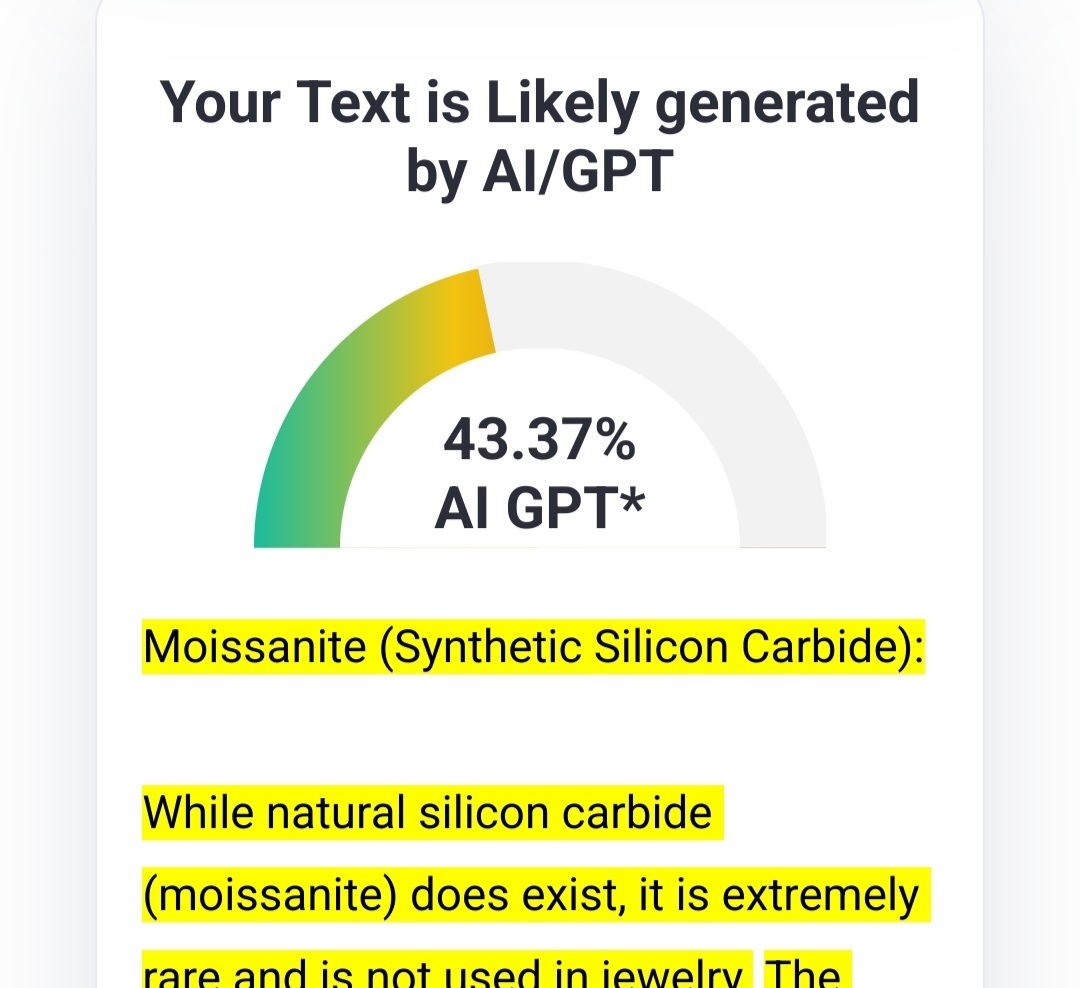https://en.wikipedia.org/wiki/Veblen_good
A Veblen good is a type of luxury good, named after American economist Thorstein Veblen, for which the demand increases as the price increases, in apparent contradiction of the law of demand, resulting in an upward-sloping demand curve. The higher prices of Veblen goods may make them desirable as a status symbol in the practices of conspicuous consumption and conspicuous leisure. A product may be a Veblen good because it is a positional good, something few others can own.
That said, part of the problem with lab-grown diamonds is that they’re not competing against a rare commodity. They’re competing against a powerful vertically integrated cartel. There isn’t any real diamond shortage, just a supply-side monopoly. There isn’t a natural high demand for diamonds, just a market saturated with aggressive advertising. There isn’t a wholesale diamond exchange judging the rocks objectively on their quality, just a series of elaborate marketing gimmicks and scammy sales goons trying to upsell you.
Diamonds have always been a racket. The one blessing of manufactured diamonds is that they’re no longer a racket putting market pressure on industrial grade diamond equipment. But the jewelry exists to separate gullible superficial status-fixated people from their money. Ethics was never part of the equation.
Best comment that I also hated reading all month.
So the answer is just to buy a lab-grown diamond, and then tell everyone it’s real, because once the poors have it, it won’t be cool anymore
At this point you’re not paying money for a diamond, you’re paying money for a certificate.
If you want to know how much a diamond is really worth, go to any jewelry store and ask them to appraise the resell value of your natural diamond ring with certificate and all, no matter how much you paid for it, they’re probably going to tell you only the precious metal setting is worth any money, and the rock itself is utterly worthless the second you received it.
Which makes diamond a terrible symbol for love.
Considering more than 50% of marriages end in divorce, maybe a worthless symbol is fitting.
“See, our love is just like a diamond: Turns to
coal under high pressure and tosmoke when heated.”
Edited for facts
Anything to the effect of “this ring isn’t expensive enough” is the only reason you need to never marry that person.
My (former) best friend got married young, and her and her husband had rings they got at the flea market that cost about 20 bucks a piece. I always respected the hell out of her for that. Her sisters tried to make it out like it was some kind of bad omen, or like it meant they didn’t love each other. She had a lot of pressure to cave into and act like a snotty brat about the cost of the rings. She never did, and loved her cheap ass flea market ring.
She turned out to be a terrible person in a multitude of other ways, but on that note, good for her.
Not the ending I was expecting.
360 nopost
I… Do not know what that means lol
I think it’s a modification of “360 noscope” which is a gaming term for an unexpected change in a game stemming from fps games like counter strike. The term basically relates to a high skill/high luck shot usually involving a quick rotation and/or flick shot, where you didn’t use the scope of the weapon to help improve accuracy, but made the shot anyways.
Basically saying it was a highly unlikely outcome…
The “nopost” which replaces “noscope” is probably their way of referencing the above while making it relevant to the context (a post).
I’ll admit, the words, taken at face value, do not make a lot of sense. The entire thing relies on a general understanding of the 360 noscope meme.
Thank you!
Also, if I’m not mistaken, this is (at least) the second time you’ve replied to me when I didn’t understand a comment, and done it in such a way to make things very understandable. Can you just follow me around explaining things to me? It’s extremely helpful!
Ha. That’s just how I am. I didn’t notice that I did that.
I appreciate the kind words, fellow lemming, and I hope you have a wonderful day.
Ha. You two are cute - keep on being awesome
Shit like that is why I think neuro-atypical people might actually be the correct psychological state and everyone else is just a “normal” animal.
I want to buy a synthetic gemstone that is impossible to be formed naturally. I’m sure there’s at least a few.
I want a stone so un-natural that the mineral is named cthulite.
In it, you see a tiny civilization. You are the cosmic horror.
Moissanite (Synthetic Silicon Carbide):
While natural silicon carbide (moissanite) does exist, it is extremely rare and is not used in jewelry. The moissanite used in jewelry is entirely synthetic. Its properties, such as brilliance and hardness, make it a common alternative to diamonds. YAG (Yttrium Aluminum Garnet):
Originally developed for industrial and laser applications, YAG is sometimes used as a gemstone. Although it is named a “garnet,” it is not related to the natural garnet family of minerals. Strontium Titanate:
Developed in the mid-20th century as a diamond simulant. It has a much higher dispersion than diamond, giving it a fiery brilliance, but it is too soft for practical jewelry use. Synthetic Rutile:
While natural rutile exists, the synthetic version created in the lab has been used as a gemstone due to its high dispersion and brilliance. The synthetic version is engineered for specific optical qualities. Titanium Sapphire (Ti:Sapphire):
A synthetic material often used in lasers. While not commonly used in jewelry, it is a synthetic gemstone that does not naturally occur in this form. These synthetic gemstones are often engineered for specific aesthetic, optical, or industrial purposes and are distinct from natural gemstones, either because they do not naturally occur in gem-quality form or because they are entirely man-made.
Synthetic Alexandrite (Czochralski or Flame Fusion):
Although natural alexandrite exists, synthetic versions often have unique compositions or colors that don’t occur naturally, created purely for novelty. Boron Nitride Crystals:
Synthetic boron nitride can be engineered into gem-like forms. It’s extremely rare in nature and appears in fascinating, unusual forms in the lab. Synthetic Opal (Novel Patterns):
Lab-grown opals can exhibit color patterns or transparency levels not seen in natural opals, such as extreme brightness or perfectly uniform “play-of-color.” Synthetic Quartz Variants:
Quartz can be synthesized with inclusions or colorations (e.g., deep purple or unique patterns) that are unattainable in natural environments. Colored Synthetic Diamonds:
Lab-created diamonds can be grown with colors that are extremely rare or impossible in nature, such as perfectly vibrant reds, blues, or even neon shades due to precise chemical doping. Bismuth Crystals:
While not technically a gemstone, synthetic bismuth crystals are grown in labs and have rainbow-colored, step-like structures not naturally found in geological settings. Synthetic Spinel:
While spinel exists naturally, synthetic spinel can be created in colors or with clarity not found in nature, such as vibrant neon hues. Synthetic Perovskites:
Perovskites are naturally occurring but rare in gem-quality form. Synthetic versions, often used in solar panels, can be cut into unusual, sparkling gems. Synthetic Corundum with Patterns:
Sapphire and ruby (corundum) can be synthesized with added colors or patterns, such as stars, gradients, or even mixed hues that are impossible naturally. Gallium Nitride Crystals:
Used in electronics but can be fashioned into gemstones with unusual optical properties, entirely absent from nature. Synthetic Fluorite Variants:
While fluorite exists in nature, synthetic fluorite can exhibit colors and patterns engineered for jewelry or purely aesthetic purposes. Zirconium Carbide or Nitride:
These materials are synthetic and metallic, with a high refractive index and an unusual, futuristic appearance when polished. Metal-Organic Framework (MOF) Crystals:
MOFs are a class of synthetic porous crystals with complex geometric structures and vibrant colors, making them unique and striking. Hyper-Modified Glass or Vitreous Materials:
Glass-like gemstones doped with rare elements (such as europium or neodymium) can fluoresce or shift colors in ways impossible in natural stones. Synthetic Garnets (Uncommon Types):
Garnets like gadolinium gallium garnet (GGG) or yttrium iron garnet (YIG) are synthesized for industrial purposes but can be cut into gemstones. These stones are not just rare but impossible to find naturally, offering a unique and unconventional aesthetic perfect for someone looking to stand out.
Synthetic Alexandrite (Czochralski or Flame Fusion):
Although natural alexandrite exists, synthetic versions often have unique compositions or colors that don’t occur naturally, created purely for novelty. Boron Nitride Crystals:
Synthetic boron nitride can be engineered into gem-like forms. It’s extremely rare in nature and appears in fascinating, unusual forms in the lab. Synthetic Opal (Novel Patterns):
Lab-grown opals can exhibit color patterns or transparency levels not seen in natural opals, such as extreme brightness or perfectly uniform “play-of-color.” Synthetic Quartz Variants:
Quartz can be synthesized with inclusions or colorations (e.g., deep purple or unique patterns) that are unattainable in natural environments. Colored Synthetic Diamonds:
Lab-created diamonds can be grown with colors that are extremely rare or impossible in nature, such as perfectly vibrant reds, blues, or even neon shades due to precise chemical doping. Bismuth Crystals:
While not technically a gemstone, synthetic bismuth crystals are grown in labs and have rainbow-colored, step-like structures not naturally found in geological settings. Synthetic Spinel:
While spinel exists naturally, synthetic spinel can be created in colors or with clarity not found in nature, such as vibrant neon hues. Synthetic Perovskites:
Perovskites are naturally occurring but rare in gem-quality form. Synthetic versions, often used in solar panels, can be cut into unusual, sparkling gems. Synthetic Corundum with Patterns:
Sapphire and ruby (corundum) can be synthesized with added colors or patterns, such as stars, gradients, or even mixed hues that are impossible naturally. Gallium Nitride Crystals:
Used in electronics but can be fashioned into gemstones with unusual optical properties, entirely absent from nature. Synthetic Fluorite Variants:
While fluorite exists in nature, synthetic fluorite can exhibit colors and patterns engineered for jewelry or purely aesthetic purposes. Zirconium Carbide or Nitride:
These materials are synthetic and metallic, with a high refractive index and an unusual, futuristic appearance when polished. Metal-Organic Framework (MOF) Crystals:
MOFs are a class of synthetic porous crystals with complex geometric structures and vibrant colors, making them unique and striking. Hyper-Modified Glass or Vitreous Materials:
Glass-like gemstones doped with rare elements (such as europium or neodymium) can fluoresce or shift colors in ways impossible in natural stones. Synthetic Garnets (Uncommon Types):
Garnets like gadolinium gallium garnet (GGG) or yttrium iron garnet (YIG) are synthesized for industrial purposes but can be cut into gemstones. These stones are not just rare but impossible to find naturally, offering a unique and unconventional aesthetic perfect for someone looking to stand out.
A lot of comments here are suspicious of you, so I’m going to try my hand at guessing whether this was AI.
Since GPTs are hilariously bad at detecting themselves, I’ll venture on the human spirit!
First, we establish truth 1: this is copy-pasted.
Although Moissanite isn’t mentioned twice, everything after “Synthetic Alexandrite” inclusively is mentioned twice. That means this was procedurally copy-pasted. Someone writing on their own would either CTRL+A then CTRL+C and make no mistakes, or not repeat themself at all.
Of course, we can also look at the half-formalized format that indicates something was copied from raw text and pasted into markdown, rather than formatted with markdown first.
Colon:
words words Colon:
words words Colon:copy-paster spotted
Second, we cast doubt that a human wrote the source.
- AI-isms vs. non AI-isms
-
Non-reused acronym definitions.
Garnets like… yttrium iron garnet (YIG)
This is probably taken straight from the Wikipedia’s site description for YIG. Usually humans don’t define an acronym only to never use it, unless they’re making a mistake, especially not for just making repeated structure. So either Wikipedia was in the training corpus or this was Googled.
-
5/23 sentences start with “While” (weak ai indicator)
-
no three-em dashes or obvious tricolons are overused (non ai-indicator)
-
no filler bullshit introduction or conclusion (non ai-indicator)
-
obvious repeated structure that you can feel (strong ai indicator)
-
Suspiciously uncreative descriptions (ai indicator)
“These stones are not just rare but impossible to find naturally, offering a unique and unconventional aesthetic perfect for someone looking to stand out.” (emphasis added)
-
Repetition of “unusual” and “rare” rather than more flavorful or useful adjectives (AI indicator)
- We’re talking synthetic stuff. Would a human write about rarity?
-
Superficial, neutral-positive voice despite length and possible source. If this was pasted from a technical blog, I’d expect it to have more “I” and personal experiences, or more deep anecdotal flavor (AI indicator)
- e.g. use of “fascinating” but doesn’t go deeper into any positivities
-
Third… let’s take a guess
So it was copy-pasted from somewhere, but I can’t imagine it being from a blog or website, and it isn’t directly from Wikipedia. It has some nonhuman mistakes, but is otherwise grammatical, neutral-positive, and repetitively structured. And it lacks that deeper flavor. So… it was an AI, but likely not openAI.
At least there aren’t any very “committal” facts, so the length but lack of depth suggests that everything’s maaaaaaybe true…
I wasted my time typing this
- AI-isms vs. non AI-isms
Hmm…

That fucking site is going to cause so much unnecessary strife and difficultly. LLMs are trained on real speech; that site is going to get is wrong constantly. We all want there to be some magic bullet or to pretend that AI is so easily clockable, but the simple truth is that it simply isn’t and all shit like this does is end up making people who actually know how to use “advanced grammar” (said sarcastically) like semicolons and em dashes have to deal with a shit ton of harassment from idiotic chuds who can’t comprehend that a real person can be more eloquent than “me like good thing!”
yeah, well… Some website said you talk like a chat bot so hahah owned! /s
The hypocrisy of using AI to ferret out AI and then to act like that gives one any right to judge…
I’m not even sure where the need for an expensive gem stone came from, diamond or otherwise.
My wedding/engagement ring came from an artist and the bands are sculpted and fit together. It’s beautiful and I never have to worry about the stone falling out of the setting, plus it was in our price range. Gem stones can be nice, not arguing against them, but rings without them can be just as pretty and more affordable.
It was a marketing campaign from De Beers. Where else would it have come from.
The fact that the human race sees scarcity as a good thing…
Is everything I need to justify misanthropy in its most literal form (Hatred of humanity)
Use to work opposite a De Beers building that had a helipad on the roof. Choppers were always flying in and out.
Thought it was the CEO coming and going by heli, but turns out they were for diamond shipments. Safer to transport them by air than on the road.
funnily in india where most of the diamonds are grinded they are just selling them on the street like it’s some spice
This. If you really want an economical alternative, moissanite is a great option. Obviously not 1 for 1, but pretty damn close for jewelry.
They arguably refract better and don’t have a history of slavery and death.






